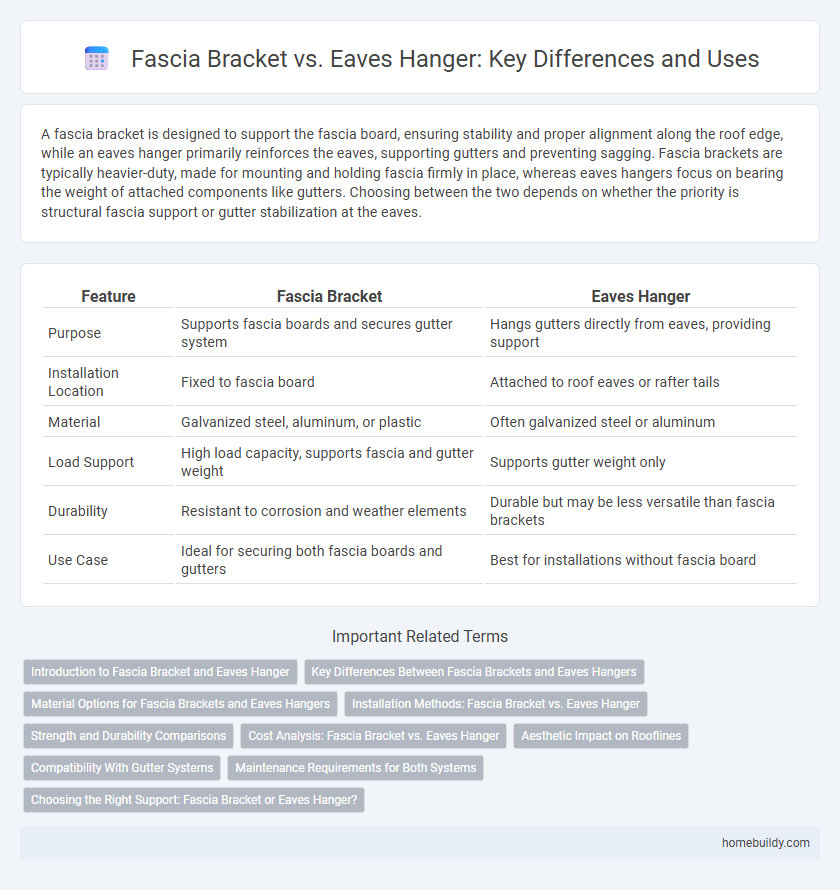A fascia bracket is designed to support the fascia board, ensuring stability and proper alignment along the roof edge, while an eaves hanger primarily reinforces the eaves, supporting gutters and preventing sagging. Fascia brackets are typically heavier-duty, made for mounting and holding fascia firmly in place, whereas eaves hangers focus on bearing the weight of attached components like gutters. Choosing between the two depends on whether the priority is structural fascia support or gutter stabilization at the eaves.
Table of Comparison
| Feature | Fascia Bracket | Eaves Hanger |
|---|---|---|
| Purpose | Supports fascia boards and secures gutter system | Hangs gutters directly from eaves, providing support |
| Installation Location | Fixed to fascia board | Attached to roof eaves or rafter tails |
| Material | Galvanized steel, aluminum, or plastic | Often galvanized steel or aluminum |
| Load Support | High load capacity, supports fascia and gutter weight | Supports gutter weight only |
| Durability | Resistant to corrosion and weather elements | Durable but may be less versatile than fascia brackets |
| Use Case | Ideal for securing both fascia boards and gutters | Best for installations without fascia board |
Introduction to Fascia Bracket and Eaves Hanger
A fascia bracket secures fascia boards to a building's structure, providing stable support for gutters while maintaining a clean roofline appearance. An eaves hanger is specifically designed to hold gutters in place along the eaves, ensuring proper water drainage and preventing sagging or damage. Both components are essential in roofing systems but serve distinct functions related to fascia support and gutter suspension.
Key Differences Between Fascia Brackets and Eaves Hangers
Fascia brackets secure gutters directly to the fascia board, providing strong support for the gutter system, while eaves hangers attach to the roof's eaves and offer a discreet, low-profile method for gutter installation. Fascia brackets are ideal for visible, accessible fascia boards, ensuring durability and ease of maintenance, whereas eaves hangers are preferred when the fascia board is narrow or inaccessible. The key difference lies in their mounting location and suitability based on roof structure and gutter visibility requirements.
Material Options for Fascia Brackets and Eaves Hangers
Fascia brackets are typically made from durable materials such as galvanized steel, aluminum, and stainless steel, offering excellent resistance to corrosion and weather elements. Eaves hangers, on the other hand, are commonly available in galvanized steel and sometimes coated metals but may lack the variety and corrosion-resistant options found in fascia brackets. The material choice for fascia brackets often results in enhanced longevity and structural support compared to standard eaves hangers.
Installation Methods: Fascia Bracket vs. Eaves Hanger
Fascia brackets are typically installed by securing them directly onto the wooden fascia board using screws or nails, providing a sturdy mounting point for gutters or other structural elements. Eaves hangers, on the other hand, attach primarily to the roof's rafters or eaves, requiring precise alignment to distribute weight evenly and support gutter systems effectively. The installation of fascia brackets generally allows for easier adjustments and maintenance compared to eaves hangers, which demand more accurate positioning during initial setup to ensure proper functionality.
Strength and Durability Comparisons
Fascia brackets provide superior strength and durability compared to eaves hangers due to their robust construction and ability to evenly distribute loads across the fascia board. Made from galvanized steel or aluminum, fascia brackets resist corrosion and maintain structural integrity in harsh weather conditions, outperforming many eaves hangers that are more prone to bending or rusting. This enhanced durability ensures fascia brackets offer long-lasting support for gutter systems and roofing components.
Cost Analysis: Fascia Bracket vs. Eaves Hanger
Fascia brackets generally offer a more cost-effective solution compared to eaves hangers due to lower material and installation expenses, making them ideal for budget-conscious projects. Eaves hangers, while often more durable and suitable for supporting heavier loads, come at a higher price point, reflecting their enhanced structural benefits. Choosing fascia brackets can reduce overall roofing costs without compromising basic functionality, especially in standard residential applications.
Aesthetic Impact on Rooflines
Fascia brackets provide a sleek and minimalist appearance that enhances the clean lines of modern roof designs, maintaining an unobtrusive profile along the roof edge. Eaves hangers, while robust and functional for gutter support, tend to be bulkier, potentially disrupting the smooth roofline and altering the building's visual harmony. Choosing fascia brackets results in a more refined and aesthetically pleasing roofline, preserving architectural integrity and curb appeal.
Compatibility With Gutter Systems
Fascia brackets offer superior compatibility with various gutter systems by securely attaching directly to the fascia board, allowing for more flexible positioning and easier adjustments. Eaves hangers, designed to support gutters underneath the roof edge, are less adaptable and may not fit all gutter profiles as effectively. Choosing a fascia bracket provides enhanced versatility and stability, especially with modern sectional and seamless gutter designs.
Maintenance Requirements for Both Systems
Fascia brackets require minimal maintenance due to their durable materials and corrosion-resistant coatings, reducing the frequency of repairs and replacements. Eaves hangers, while robust, may necessitate regular inspections and occasional tightening or cleaning to prevent rust and debris buildup in gutter systems. Choosing fascia brackets can result in lower long-term upkeep costs compared to traditional eaves hanger installations.
Choosing the Right Support: Fascia Bracket or Eaves Hanger?
Fascia brackets provide strong, secure support for gutter systems by attaching directly to the fascia board, making them ideal for areas with heavier rainfall or snow loads. Eaves hangers, on the other hand, fasten to the roof deck beneath the eaves, offering a sleeker profile but potentially less load capacity. Selecting between fascia brackets and eaves hangers depends on regional weather conditions, roof design, and the desired balance between structural support and aesthetic appearance.
Fascia bracket vs Eaves hanger Infographic

 homebuildy.com
homebuildy.com